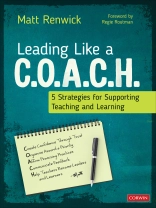Expand your leadership capacity to help your school reach its potential
All schools have the capacity for schoolwide instructional excellence. Schools with leaders who adopt a coaching stance as part of their practice are more likely to realize this success. Leaders achieve success with their teachers, their students, and their families, not alone.
Leading like a C.O.A.C.H. reframes the approach to schoolwide change from a leader acting alone to a leader working with a community in which each member contributes their strengths and ideas to improving instruction. Renwick, a well-known blogger and writer on literacy and leadership, encourages school leaders to embody five practices: 1. Create confidence through trust; 2. Organize around a priority; 3. Affirm promising practices; 4. Communicate feedback; and 5. Help teachers become leaders and learners. Throughout this practical guide, readers will find
- Reflective questions
- Activities
- Indicators of success
- Examples of leaders coaching teachers to excellence
- Wisdom from the field
This book provides new and veteran leaders with a practical approach and easily adoptable ideas for helping their schools realize their full potential.
Inhoudsopgave
Acknowledgments
About the Author
Foreword by Regie Routman
Introduction
The Purpose of This Book
My Coaching Journey
Reflective Questions
Chapter 1: Why Should I Lead Like a Coach?
Benefits of Leading Like a Coach
Expand on Your Current Identities
Shifting Toward a Coaching Stance
Reflective Questions
Chapter 2: How Instructional Walks Help Leaders Adopt a Coaching Stance
Introducing Instructional Walks
The Instructional Walk Process
From Judging to Learning
What Instructional Walks Are Not
Reflective Questions
Chapter 3: Create Confidence Through Trust
Defining Trust
Four Conditions for Trust
Condition 1: Consistency
Condition 2: Compassion
Condition 3: Communication
Condition 4: Competence
Success Indicators for Creating Confidence Through Trust
Reflective Questions
Chapter 4: Organize Around a Priority
Defining a Priority
Step 1: Analyze and Understand Your Current Reality
Step 2: Examine Your Beliefs About Instruction
Step 3: Engage in Focused Professional Learning
Step 4: Create Collective Commitments Around Promising Practices
Success Indicators for Organizing Around a Priority
Reflective Questions
Chapter 5: Affirm Promising Practices
Four Principles for Initiating Positive Change
Principle 1: Adopt an Instructional Framework
Principle 2: Learn With Your Faculty
Principle 3: Develop Collaborative Learning Communities
Principle 4: Institutionalize Promising Practices
Success Indicators of Affirming Promising Practices
Reflective Questions
Chapter 6: Communicate Feedback
Defining Feedback
Communicating Feedback Through Engagement (vs. Bypass)
Differentiating Feedback to Meet Teachers’ Needs
Example 6.1: Exploring New Ideas for Classroom Management
Example 6.2: How the Task Supports Student Engagement
Example 6.3: A Better Way to Assess
Success Indicators for Communicating Feedback
Reflective Questions
Chapter 7: Help Teachers Become Leaders and Learners
A Journey to Excellence
Example 7.1: Teacher Self-Assessment (Wilmot Elementary School, Jefferson County Public Schools, Denver, Colorado)
Example 7.2: Residency Model for Professional Development (Winnipeg School District, Winnipeg, Manitoba, Canada)
Success Indicators of Helping Teachers Become Leaders and Learners
Final Reflective Questions
Conclusion: What Will Be Your Legacy?
References
Index
Over de auteur
Matt Renwick has served in public education for over 20 years. He started as a 5th and 6th-grade teacher in a country school outside of Wisconsin Rapids, WI. Matt now serves as an elementary principal for the Mineral Point Unified School District. See more of his work at https://mattrenwick.com/.












